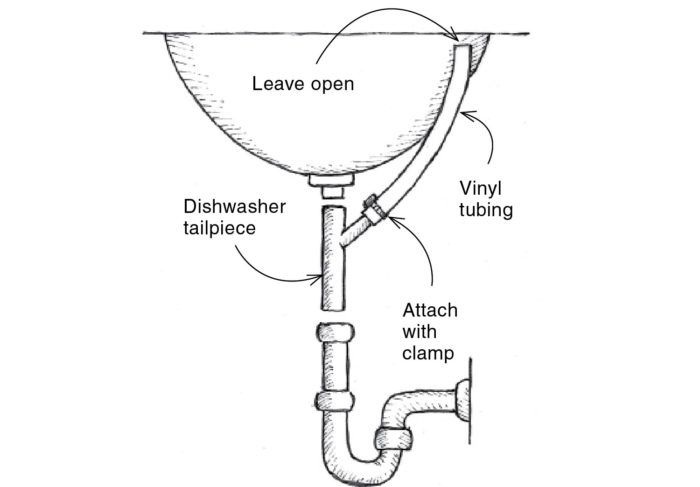Adding an Overflow to a Sink
A simple way to re-create the air-release feature in sinks without overflows.

Beautiful vessel sinks made of stone, copper, granite, and marble are very popular in bathroom remodels. Unfortunately, they often drain very slowly because they don’t have built-in overflows. Though not its stated purpose, a secondary benefit of an overflow is to release trapped air when water flows down the drain. I’ve found a simple way to re-create the air-release feature in sinks without overflows. I use a dishwasher tailpiece (in place of the regular tailpiece) and clamp a piece of sturdy vinyl tubing to it. I leave the other end of the vinyl tubing open. It allows air to escape, and water flows rapidly down the drain. For pedestal sinks, you can run the vinyl tubing behind the sink so it’s less obtrusive. And because the work is all done upstream of the trap, there’s no danger of releasing sewer gasses.
— Nick Fera, Brielle, N.J.
Edited and illustrated by Charles Miller
From Fine Homebuilding #268



























View Comments
I did not know of the secondary benefit of the overflow. It is good to know.
It is also illegal if it does not rise to at least one inch above the rim of the sink, no matter what side of the trap it is on. Besides, if the drain is plugged further down the pipe than the dishwasher tailpiece and the water backs up it will overflow itself. SURPRISE, the owner won't know it until its too late because it's 'under the sink'. Can't imagine the mess if it's buried in the wall.
I think the issue with the sink not draining is because it isn't well vented. Perhaps venting is more critical with vessel sinks. I have two vessel sinks and there is absolutely no problem with the speed with which it empties.
Not sure where Nick got his Plumbing License, but if he actually has one then he needs to go back to apprenticeship 101. The overflow has nothing to do with whether the sink drains properly, it's all about a properly vented drain. All Nick is going to get you when that trap plugs is a cabinet full of waste water. Fine Homebuilding really needs to verify some of these yahoos solutions to problems.
labrousser,
I have 2 sinks without overflows with grid style always-open drains. (As there are no parts for hair and debris to snag on, they never clog.) However, when water flows over all the holes in the grid, that creates a closed pocket of air between the grid drain and the top of the water in the trap below. That trapped air pocket is enough to cause the water to drain slowly. Grid drains are common in vessel sinks I believe. I found that the solution presented here is an outstanding solution that does work. The diagram shows the tube opening as high as possible under the sink. So if there is a clog in the drain then the sink would start to fill up and the user would see the sink filling up. You're wrong to suggest that "all Nick is going to get when that trap plugs is a cabinet full of waste water". Perhaps it is you that needs to "go back to apprenticeship 101".